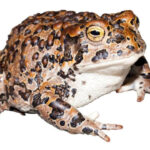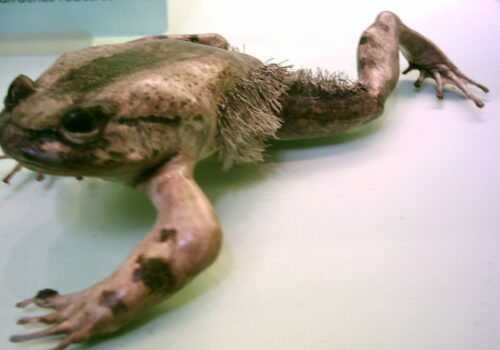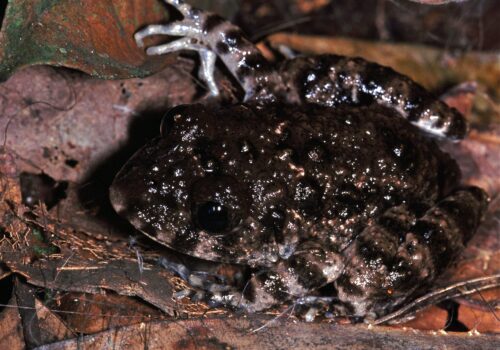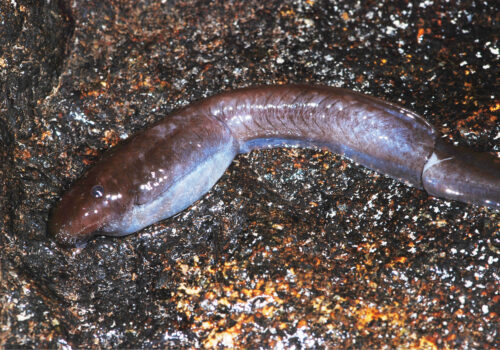Exploring the Enchanting World of Leptopelis parbocagii: A Jewel of Africa’s Rainforests#
Amid the lush, verdant canopies of Africa’s vibrant rainforests, a delicate call intertwines with the whispers of the tropical night. It’s a subtle sound, easily lost unless one pays careful attention—a trill so soft, yet profoundly meaningful in the complex language of biodiversity. The owner of such an enigmatic melody is the Leptopelis parbocagii, a fascinating tree frog species thriving quietly within its verdant home. Known commonly as the Northern Forest Tree Frog or Bocage’s Tree Frog, this captivating amphibian serves as an indicator of environmental health, embodying the delicate balance of its ecosystems caught between vibrant flourishing and stark vulnerability.
With each day placing increasing demands on the natural world, amphibians like Leptopelis parbocagii reveal much about our planet’s stability. Their presence is a comforting reassurance, yet their absence signals ecological alarm. Let us journey into the misty depths of Africa’s forested realms—home of this captivating frog species—and explore its life, ecological role, significance, and ongoing conservation concerns.
Taxonomy and Classification#
Leptopelis parbocagii belongs to the family Arthroleptidae, an intriguing group of tree frogs and terrestrial frogs predominantly found across Africa. Within the Arthroleptidae family, Leptopelis genus comprises numerous species renowned for their arboreal habits, often distinguished by unique morphological adaptations enabling them to navigate life amidst the treetops.
Initially described by renowned herpetologist Günther in 1869, this species has witnessed revisions and clarifications in taxonomy as science has refined our understanding over time. Leptopelis parbocagii owes its common name, Bocage’s Tree Frog, to José Vicente Barbosa du Bocage, a distinguished Portuguese naturalist recognized for his extensive work in Africa’s wildlife exploration during the 19th century.
Natural Habitat#
Leptopelis parbocagii is primarily found weaving through the undergrowth and ascending into the rainforest canopies of Central and West Africa. Its range spans regions within Cameroon, Equatorial Guinea, Gabon, and parts of the Republic of Congo, countries that house some of the richest and most biologically diverse rainforests on Earth.
Habitat Preferences and Microclimates#
This captivating amphibian typically favors moist, subtropical or tropical rainforest ecosystems, particularly dense primary forests and sometimes secondary-growth areas where humidity levels remain high and foliage lush. The species often inhabits the canopy and mid-level strata of forests but occasionally descends closer to streams and forest floor pools for breeding.
Thriving in environments with consistent rainfall and moderate temperatures, Leptopelis parbocagii relies on stable, humidity-rich microclimates essential for skin moisture regulation—a crucial factor given amphibians’ reliance on cutaneous respiration. The intricate webbing of leaves, vines, bromeliads, and moss provides ideal camouflage and humidity retention, showcasing the intimate relationship between organism and habitat.
Physical Characteristics#
Leptopelis parbocagii is a remarkable sight, effortlessly encapsulating the beauty and ingenuity of evolutionary artistry. Adults typically measure between 35-45 mm, showcasing moderate sexual dimorphism, with females being slightly larger than males—an adaptive trait beneficial during egg production.
Coloration and Markings#
Characterized by shades that range from delicate green and olive to subtle browns and grays, these frogs exhibit excellent camouflage among the leaves and branches of their tropical home. Distinctive dark markings and occasionally speckled patterns enhance their concealment, allowing them to evade predators effortlessly.
Eyes marked by pronounced, horizontal pupils grant these frogs exceptional night vision capabilities—a distinct advantage for nocturnal hunters. Their limbs are slender yet strong, equipped with flattened discs at the tips of the toes, adaptations crucial for their arboreal lifestyle. These adhesive pads empower effortless movement throughout vertical and horizontal planes of tree branches, an evolutionary masterpiece for life among tree canopies.
Behavior and Life Cycle#
Nocturnal Wonders of the Canopy#
Exuding primarily nocturnal behaviors, Leptopelis parbocagii’s activity peaks after twilight. As night falls, the confines of the forest awaken to their gentle symphony: males perched strategically in elevated positions begin their melodious calls—a soft, repetitive trill designed to attract receptive mates and define territorial boundaries. Echoes of their calls resonate softly, blending harmoniously into the nocturnal symphony of insects and other forest inhabitants.
Diet and Hunting Strategies#
Leptopelis parbocagii showcases keen predatory instincts, hunting for insects such as moths, crickets, beetles, ants, and other small arthropods inhabiting the forest canopy. Patient hunters, these frogs typically adopt a sit-and-wait tactic, relying on their color patterns and stillness for concealment as prey approaches unwittingly. Rapid and accurate strikes capture prey using their agile, sticky tongues—a hallmark of amphibian predation efficiency.
Reproductive Behaviors and Development#
The arrival of seasonal rains marks the onset of breeding behavior as males engage in active vocal displays, signaling readiness and territory. Upon mate selection, females deposit gelatinous egg masses on vegetation above temporary water bodies or damp forest floors. Upon hatching, the larvae, known as tadpoles, drop into water, initiating their aquatic developmental stage submerged within less-predatory shallows of forest pools or streams.
During metamorphosis, these tadpoles undergo extraordinary transformations—a ballet of biological transition—as they equip themselves for terrestrial and arboreal existence. Thus, a new generation emerges, ready to play its essential role in the continuity of this remarkable species.
Ecological Role#
Within its rainforest ecosystem, Leptopelis parbocagii functions as an essential conduit within intricate food webs. Acting as both predator and prey, it helps maintain healthy insect populations and provides a crucial food source for snakes, larger frogs, birds, and even small mammals. Amphibians often represent sensitive biological indicators of ecosystem health; fluctuations in their populations serve as clear environmental signals, reflecting broader changes within habitat quality and stability.
Threats and Conservation Status#
Although currently listed as Least Concern by the International Union for Conservation of Nature (IUCN), this species’ continued well-being relies upon intact forests and stable environments. Ongoing habitat destruction, logging practices, agricultural expansion, and climate changes pose looming threats to their habitat integrity and population viability.
Conservation Efforts and Future Directions#
Protected areas and reserves throughout Central and West Africa provide essential refuges for the delicate wilderness habitat that supports Leptopelis parbocagii populations. Active monitoring, research, community-based conservation, responsible forestry practices, and habitat preservation initiatives form pillars of effective conservation management geared towards safeguarding these charming amphibians and their habitats.
Cultural and Scientific Significance#
Within local cultures, similar species are often imbued with symbolic meanings linked to rainfall, fertility, and environmental harmony, illustrating humanity’s timeless fascination and deep connection with amphibians. Scientifically, tree frogs like Leptopelis parbocagii can inspire biomimetics—investigations enabling technological advancements such as adhesive engineering inspired by their remarkable climbing prowess. They also provide biological indicators essential to understanding eerie global amphibian declines impacting biodiversity worldwide.
Conclusion#
Leptopelis parbocagii does not merely exist—it sings, hunts, breeds, navigates, thrives, and ultimately represents an intricate interwoven tapestry of life amidst Africa’s flourishing yet vulnerable rainforests. This captivating amphibian reminds us that even the smallest species harbors immense significance within the natural world, emphasizing our duty to cherish, protect, and preserve these remarkable follies of evolution.
Understanding and appreciating these subtle narratives woven deeply within nature invites broader awareness, beckoning all of us to partake positively in protecting wildlife and engaging with meaningful conservation actions. Through curiosity, care, and commitment, we can ensure Leptopelis parbocagii—and countless other hidden treasures of Earth’s forests—sing softly into the nights for generations to come.










